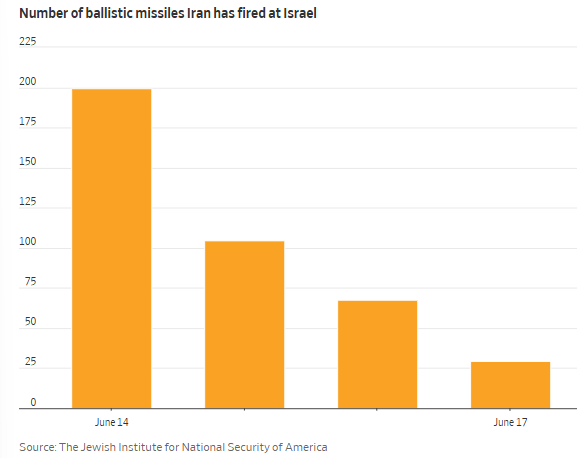Iran is firing fewer missiles at Israel each day after Israel secured dominance over Iranian skies, enabling it to destroy launchers and take out missiles before they even leave the ground.
Israel said on Sunday that it had created an air corridor to Tehran. By Monday, it said its air force had complete control over the skies of Tehran. Since then it has struck dozens of missile launchers amounting to more than a third of Iran’s total, the military said, sometimes just as they are preparing to launch an attack.
On Wednesday, the military said it had struck overnight a loaded “Emad” missile launcher as it was about to be fired toward Israel. The air force has also been striking daily Iran’s supply of missiles, detection radars and missile batteries, in the wake of Israel’s Thursday night attack on Iranian nuclear facilities and senior leadership.
This aerial control is proving crucial. Iran fired some 200 missiles in four barrages in its first round of attacks against Israel on Friday and Saturday. But between Tuesday and Wednesday, Iran fired 60 missiles at Israel over eight different waves of strikes, at times sending fewer than a dozen at a time, according to estimates by Washington-based Jewish Institute for National Security of America.
Fewer missiles at a time makes it easier for Israeli air-defense systems to intercept them, according to Israeli officials and air-defense experts. There have been no casualties from missile attacks in Israel since Tuesday, according to Israeli paramedics. Twenty-four Israelis have been killed as a result of Iranian strikes since the current confrontation began.

Iran’s plan, according to statements by senior Iranian military officials before the war, was to overwhelm Israeli air defenses by firing around 400 missiles a day against Israel, said Farzin Nadimi, a senior fellow with the Washington Institute.
“Those plans were all shattered when Israel just defeated Iran’s integrated air-defense systems, and within a short period,” Nadimi said.
Israel’s aircraft and other security forces have destroyed 120 missile launchers, squeezing Iran’s capability to strike Israel, according to Israeli officials. Israel’s control over Iranian skies means it is also been regularly striking Iran’s missile storage and production capabilities.
Iran started the current conflict with around 2,000 ballistic missiles capable of reaching Israel, and has fired around 400 of those so far, according to Israeli military estimates. Experts say Iran has a lot more missiles and many more other kinds of missiles in its arsenal, but it isn’t clear how many of those are able to hit faraway targets like Israel.
Some analysts are also speculating that Iran may be withholding large salvos ahead of a possible expansion of the war. President Trump issued threats against Iran and its leadership on Tuesday, suggesting the U.S. could join the war.
Israel’s aerial dominance is providing the country with some confidence that the impact of the conflict could be contained, at least in Israel. On Wednesday, Israel’s airport authorities allowed the first flight to land at Ben Gurion international airport since the start of the current conflict, indicating it feels it has some control over the airspace. Israel’s home front command, also on Wednesday, said it would lift some of the restrictions on public gatherings and allow businesses with or near bomb shelters to reopen. Israel has bomb shelters built all around the country and dotting its cities, making many businesses in range of protection.
Israel’s ability to spot, foil and intercept launches is likely forcing the Iranians to be more careful about moving missile launchers around, because moving makes them more vulnerable to attack, said Yaakov Amidror, a former Israeli national security adviser and fellow at JINSA.
Amidror said Israel has also succeeded in disrupting Iranian command-and-control by targeting its senior and midlevel commands, further reducing their ability to coordinate large missile attacks.
“Take all the elements together and they still have a huge potential and may use it in the future, but for the time being Israel has degraded their ability to launch big salvos at many times during the day,” Amidror said.
Fabian Hinz, research fellow for missile technologies and UAVs at the International Institute for Strategic Studies, said that Iran is now having to fire missiles at Israel from farther away, which means they are relying mainly on their liquid propellant weapons that have sufficient 1,000-mile range to hit Israel.
These liquid propellant ballistic missiles have a number of disadvantages compared with solid propellant missiles, according to Hinz, which is why Iran has been focusing its work on developing longer-range solid propellant missiles in recent years.
The biggest disadvantage is they take a considerable amount of time—perhaps a couple of hours—to fuel up, which means Iran can’t fire a quick barrage of missiles, as they can with solid propellant missiles. That leaves them more exposed to Israeli strikes.
Originally published in the Wall Street Journal.
